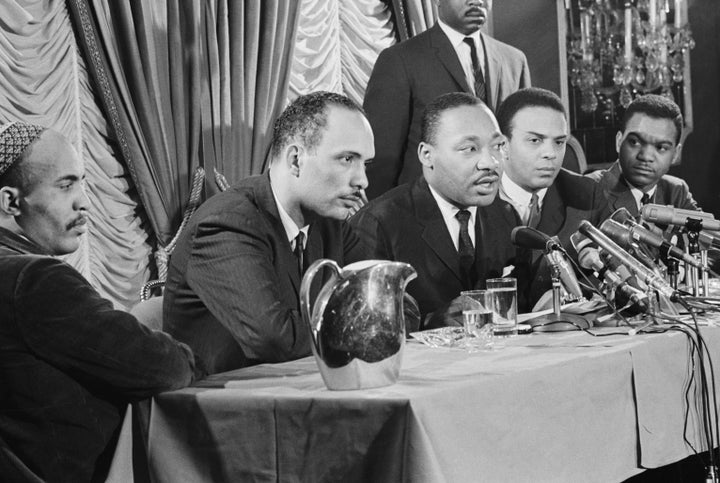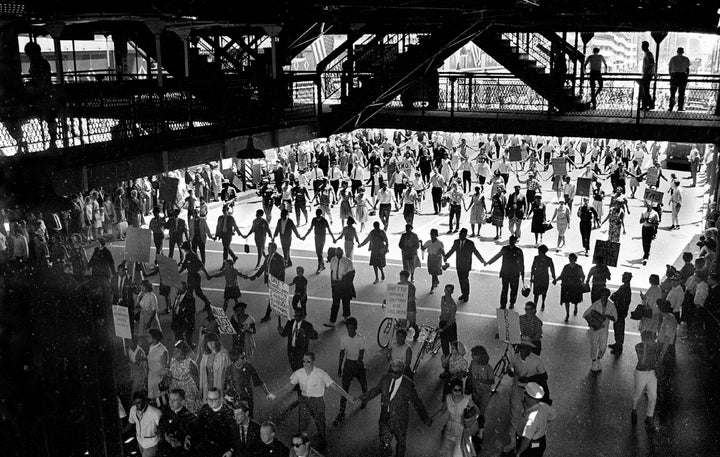
Half a century ago, the U.S. had near-apartheid levels of housing segregation. The blame lay with all levels of government, banks, real estate brokers and developers for decades of discrimination. A government report warned bluntly that “our nation is moving toward two societies, one black, one white ― separate and unequal.”
Martin Luther King Jr. and President Lyndon Johnson both knew that a federal fair housing law would be necessary to fix the problem. They’d had previous civil rights victories in the areas of employment, public accommodations and voting, but housing would prove to be more difficult. The first attempt at a Fair Housing Act had died in the Senate in 1966. That same year, King brought his open housing movement north to Chicago and was met with mobs he described as more “hostile and hate-filled” than he’d encountered in the Deep South.
Things did not seem promising in the spring of 1968. A second version of the Fair Housing Act had passed the Senate but was stalled in the House. Johnson had just announced that he would not run for re-election, his political capital drained by the war in Vietnam. Then, on April 4, King was assassinated in Memphis, Tennessee. Unrest broke out across the country, including in Washington, D.C., mere blocks from the Capitol. Stunned, Congress quickly passed the Fair Housing Act, which Johnson signed into law on April 11.
Fifty years later, we’ve made progress ― but not enough. The most overt and egregious discriminatory practices subsided over time, yet the expected benefits of the law largely failed to materialize.
It isn’t enough for banks, cities and developers to simply stop discriminating. Taking no action simply perpetuates the status quo.
Although illegal, individual acts of discrimination against minority home seekers are estimated to number in the millions each year. Segregation levels have decreased but remain high, especially in metropolitan areas with the largest minority populations. While some of this is caused by the disparity in wealth between racial groups (which itself is the product of historic housing discrimination), segregated patterns hold even when income is controlled for.
To make matters worse, black and Latino borrowers were heavily targeted by predatory lenders in the 2000s, and the resulting foreclosure crisis wiped out much of the gains in minority homeownership and wealth accumulation that were made in previous decades.
Why is the picture so disappointing? In part, it’s because housing is a slow-moving indicator. A municipality that has spent decades engaging in exclusionary zoning and limiting its affordable housing stock to majority-minority neighborhoods would have to take affirmative steps to break up the segregated patterns that result. A bank that has spent years redlining minority neighborhoods has deprived those neighborhoods of mortgage capital, which depresses home prices and leads to the deterioration of housing stock, a situation that isn’t easy to repair.
It isn’t enough for banks, cities and developers to simply stop discriminating. Taking no action simply perpetuates the status quo. That is why Congress made it part of the mission of the Department of Housing and Urban Development to make sure that the grants it administers to municipalities, most notably through its Community Development Block Grant program, are used in a manner that is “affirmatively furthering fair housing.” This means grant recipients should look carefully at the racial impact their development projects will have, analyze impediments to fair housing in their community, and cooperate in regional planning efforts.
Unfortunately, HUD is currently headed by a secretary who likened the notion of requiring its program participants to promote fair housing to the “failed socialist experiment” of busing. (That might not matter in the end because President Donald Trump’s proposed budget would eliminate the Community Development Block Grant program altogether.)
Residential segregation is inextricably tied to economics. It’s impossible to talk about fair housing without taking a close look at affordable housing policy, housing finance and residential zoning laws. There is a desperate need for affordable housing everywhere. There is no place in the United States where a low-wage employee working full time can rent a two-bedroom apartment without spending more than 30 percent of her gross income on rent (a condition described as “cost-burdened”). Over 11 million severely cost-burdened households in America spend more than 50 percent of their gross income on rent.

In the face of such private market failures, government action is needed, but it has been woefully inadequate. Only 25 percent of the low-income households that qualify for Section 8 vouchers actually receive them because the program isn’t funded anywhere near the level that full coverage requires. (You can guess what happens to these funds in the Trump proposed budget.) Financing and development of low-income housing is complicated, time-consuming and often brings controversy if it is done anywhere outside of already poor areas. Given this struggle to meet such a basic human need, local governments can and do lose sight of the importance of combating housing segregation when they make these complex and politically fraught decisions.
Another reason the vestiges of housing discrimination are so hard to eliminate may be because they are so all-encompassing. “The housing market is interconnected with economic and social life,” Justice Stephen Breyer observed in a recent Supreme Court opinion. “A violation of the FHA may therefore be expected to cause ripples of harm to flow far beyond the defendant’s misconduct.” In other words, the legacy of state-sponsored housing discrimination is the water we swim in, and this can paradoxically cause us to lose sight of it ― or worse, to assume it is intractable.
As the Fair Housing Act turns 50, we would do well to remember the struggle to pass it and be honest about what it will take to realize the law’s promise: vigilance, commitment and cooperation.
Rigel C. Oliveri is the Isabelle Wade and Paul C. Lyda Professor of Law at the University of Missouri. Prior to entering academia, she served as a trial attorney with the U.S. Department of Justice civil rights division, housing and civil enforcement section.
